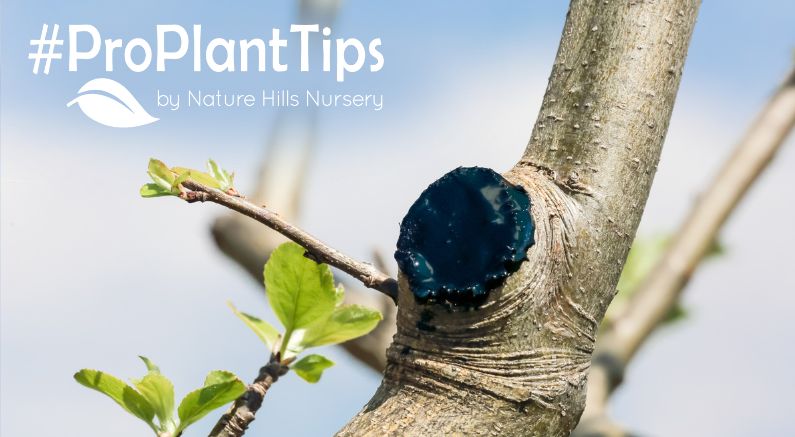
When it comes to pruning your trees and shrubs, it may seem logical to want to protect the fresh cuts with something extra, like a pruning sealant. Also known as Pruning Paint, Tree Wound Sealer, and Tree Paint, these dark, tar-like substances are marketed as a way to prevent disease and promote healing.
While it might feel like sealing a wound helps, trees don't heal like people; they seal shut tight. Applying a coating often traps moisture, encourages decay, and disrupts mother nature's own defense systems. Most of the time, a healthy tree is fully capable of sealing off cuts and protecting itself without interference.
In fact, improper sealing can turn a simple pruning job into a lingering problem. Instead of reaching for the can, it's time to trust in better techniques and let your landscape breathe.
The truth is: pruning sealants can do more harm than good. Today, we'll explore what they are, why they're outdated, and what practices actually support plant health after pruning.
What Is a Pruning Sealant?
Pruning sealants or paints are petroleum-based or latex products that are applied to freshly cut branches. They create a physical barrier, supposedly to protect the wound from insects, fungi, and moisture.
These were once a staple in garden sheds everywhere, especially promoted for fruit trees and shade trees. The idea was that "sealing" a wound would help the plant heal faster, much like a bandage.
Why You Should Skip The Seal
Modern horticultural science shows us that trees and shrubs don't just heal after injury; they seal. That's right, plants naturally compartmentalize wounds using their own protective tissues. Slapping on pruning sealants can potentially:
- Trap Moisture: Sealants can lock in moisture and invite decay rather than prevent it.
- Promote Rot: Instead of keeping pathogens out, they can actually create a cozy space for bacteria and fungi.
- Block Natural Defense: Trees form callus tissue that closes wounds over time. Sealants interfere with this process.
So, instead of helping, sealants may delay recovery and encourage disease.
What Works Better?
Instead of reaching for a pruning product, reach for proper timing and technique. Here's what promotes healthy healing:
- Prune at the Right Time: Late winter or very early spring is ideal for most trees before active growth begins. Depending on your tree, you will want to prune after the first flush of growth, after flowering, or while the tree is dormant.
- Make Clean Cuts: Use sharp, sanitized tools to avoid crushing or tearing bark.
- Cut Outside the Branch Collar: This swollen area at the base of the branch contains specialized cells that seal off wounds naturally.
- Skip the Sealant: Let mother nature do her thing! A healthy tree will seal off pruning wounds all on its own.
Also, avoid pruning during wet or humid conditions, when disease pressure is high.
Conditions When You May Want To Use Sealant
1. Preventing Oak Wilt in Certain Regions
In areas where Oak Wilt disease is a threat (especially in the Midwest and South), tree experts may recommend applying a thin coat of latex-based pruning sealant immediately after cutting Oak Trees during the growing season. This is to deter Nitidulid beetles, which spread the disease and are attracted to fresh sap.
- Timing matters: Pruning Oaks during dormant winter months avoids this need altogether.
- Use only as directed: Light application, and only on cuts made out of season.
2. Grafting and Budding
During fruit tree grafting or budding, a specialized sealant or grafting compound is applied to protect the union from drying out, moisture intrusion, and pests while the plant tissues fuse.
- These are formulated for flexibility and breathability. Unlike thick tar-like pruning paints.
- Products like grafting wax or parafilm are commonly used.
3. Mechanical Damage or Large Wounds
For large wounds from storm damage or mechanical injury, sealants are sometimes applied not to help the tree heal, but to temporarily deter pests or pathogens while the tree starts to compartmentalize the wound.
- This is more of a short-term measure than a healing aid.
- Arborists might use it when immediate pest pressure is high, especially in urban environments or on an already stressed tree.
4. Disease-Prone Trees in Humid Climates

Some fruit trees, like stone fruits (e.g., Peaches and Plums), are very prone to fungal infections after cuts in warm, wet conditions. In these cases, a very light, breathable dressing may be used on large cuts as part of a broader disease management plan. Learn more about pruning Fruit Trees Here.
When in Doubt? Skip It or Ask an Arborist
Unless you're dealing with a specific disease-prone tree or performing a graft, nature's own methods, clean cuts, good timing, and healthy care are still best. When in doubt, a certified arborist can provide guidance tailored to your tree species, region, and climate.
Let mother nature Seal The Deal
The urge to "help" plants with pruning sealants is well-meaning, but misguided. Trust in the biological wisdom of your trees. With the right clean cut at the right time, your plants will be just fine, without the tar and goop.
Happy Planting!

